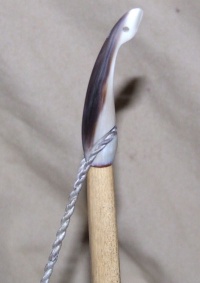Nock: Difference between revisions
No edit summary |
No edit summary |
||
| Line 1: | Line 1: | ||
A '''nock''' is a recess into the end of an [[arrow]] or at the tip of a [[bow]]. The term is also applied to a structure that covers a section of an artefact and performs the same function, such as the [[horn]] nocks of the [[medieval]] [[longbow]]. |
[[image:hornbownock.jpg|right|200px|thumb|Replica nock for a longbow.]]A '''nock''' is a recess into the end of an [[arrow]] or at the tip of a [[bow]]. The term is also applied to a structure that covers a section of an artefact and performs the same function, such as the [[horn]] nocks of the [[medieval]] [[longbow]]. |
||
Nocks in [[arrow]]s are termed ''self nocks'' if they are cut directly into the end of the shaft or stele. At times they may have also had a sliver of [[horn]] inserted into the end (crosswise to the nock) to act as a reinforcement to the shaft. [[Bronze]] nocks are known from [[Viking]] [[Hedeby]] but they are not common and thought to be possible the [[hunting]] arrows of a rich individual and should be thought typical. |
Nocks in [[arrow]]s are termed ''self nocks'' if they are cut directly into the end of the shaft or stele. At times they may have also had a sliver of [[horn]] inserted into the end (crosswise to the nock) to act as a reinforcement to the shaft. [[Bronze]] nocks are known from [[Viking]] [[Hedeby]] but they are not common and thought to be possible the [[hunting]] arrows of a rich individual and should be thought typical. |
||
Revision as of 19:47, 17 March 2006
A nock is a recess into the end of an arrow or at the tip of a bow. The term is also applied to a structure that covers a section of an artefact and performs the same function, such as the horn nocks of the medieval longbow.
Nocks in arrows are termed self nocks if they are cut directly into the end of the shaft or stele. At times they may have also had a sliver of horn inserted into the end (crosswise to the nock) to act as a reinforcement to the shaft. Bronze nocks are known from Viking Hedeby but they are not common and thought to be possible the hunting arrows of a rich individual and should be thought typical.
Nocks in bows might be cut into the side of the limb on one or both sides or they might be made in horn and attached to the end of the limb.
The term nock is also used to describe the action of placing an arrow on the string of a bow so that the string fits inside the nock itself.
